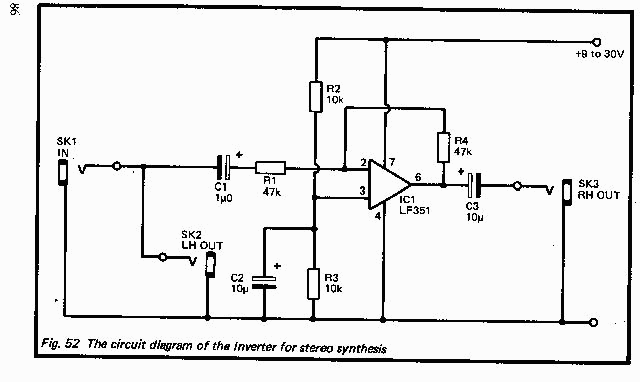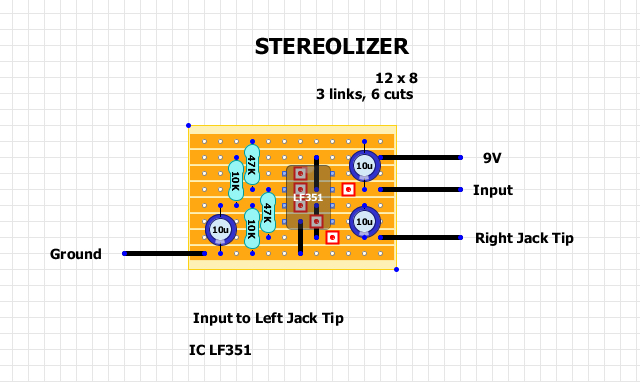Stereolizer
|
Hallo, is it some kind of mono to stereo? Does it works with only wet signal or with dry signal too? Do you have more information - schematics about this? Thank you!
|
|
Hi Sergio here it comes
Pseudo Stereo
With most electronic music being recorded in stereo, or reproduced through stereo loudspeakers when played "live", the production of a good stereo image is a topic which is of great importance to many musicians. With a monophonic synthesiser, or a multichannel instrument which has a common audio output socket for all the channels, it is not possible to produce a genuine stereo output. Of course, it is possible to combine the outputs of several instruments to generate a real stereo output, or a pseudo stereo signal can be generated from a monophonic source. The latter is the subject that we will persue first.
The most simple form of stereo simulation is to simply reverse the phase of one channel. The stereo effect relies on the two loudspeakers being driven in-phase (i.e. the diaphragms of the two loudspeakers move backwards and forwards in unison, rather than with one going forwards as the other goes backwards). With the same signal applied to the loudspeakers and the two units driven in-phase, the sound seems to emanate from a point mid-way between the two loudspeakers. Making the volume from one loudspeaker higher than that from the other shifts the stereo image towards the loudspeaker which provides the higher volume level. In fact making one loudspeaker twice as loud as the other has the effect of moving the stereo image right over to the louder of the two units. Reversing the phase of one of the loudspeakers destroys the phase relationship needed to give a good stereo image, and tends to spread out the sound between the two loudspeakers, giving a very basic (and admittedly rather crude) form of pseudo stereo effect.
The most simple way of reversing the phase of one channel is to reverse the leads to one of the loudspeakers, and it does not matter whether this is the left or right speaker. This is often an inconvenient way of doing things in practice since the connections must be returned to the normal (in-phase) method of connection for normal stereo listening. The alternative is to add an inverter stage into the signal path to one input of the amplifier-, as shown in the circuit diagram of Figure 52. This is just a basic operational amplifier inverting mode circuit, with negative feedback network Rl - R4 having values which give unity voltage gain.
This ultra-simple approach is not-without its drawbacks, and the main one is that the sound tends to move away from the middle of the sound stage and seems to come predominantly from the two loudspeakers. This gives the so-called "hole in the middle" effect, and a what is often a rather unconvincing stereo effect.
There are other approaches to generating pseudo stereo signals, but these really boil down to just two basic methods. One method is based on phasing, and consists of more sophisticated versions of the technique described previously. The other relies on frequency selective channelling of signals to the two loudspeakers. In its most basic form the frequency selective approach has a highpass filter to channel signals at high-middle and treble frequencies to one loudspeaker, and a lowpass filter to channel low-middle and bass frequencies to the other. The two filters have complementary responses so that there is no overall effect on the frequency response of the system. In theory a fairly high pitched instrument appears in one channel while a low pitched type appears on the opposite side of the sound stage. Medium pitched instruments appear at or near the middle of the sound stage.
In practice this system often fails to give really convincing results. One problem is that only a very narrow range of frequencies give a central stereo image, and the "hole in the middle" effect is often very evident. Another is that any noise on the input signal of the white noise "hissing" variety is fed predominantly to one channel, giving a relatively poor signal to noise ratio from one channel and a very high signal to noise ratio from the other. This can be a little disconcerting when listening to a pseudo stereo system of this type @ Also, any low frequency hum may be channelled to one loudspeaker, making its presence more obvious than would otherwise be the case.
Improved results can be obtained using two complementary comb filters. These are filters which have numerous peaks and troughs in their frequency responses, and the idea is to have the peaks of one filter matching the troughs of the other filter. This gives a reasonably flat overall frequency response, but also gives the required channelling of some frequencies to one channel and other frequencies to the second channel. As some high frequency signals go to one channel, and others go to the second channel, this arrangement does not suffer from the problem of having all the background "hiss" going to one channel. The only real drawback of this system is that it is relatively expensive as the two comb filter responses can not be obtained using very simple circuitry.
The best low cost approach that I have tried is a variation on the out-of-phase system. However, rather than simply having the two channels out-of-phase, improved results can be obtained by using a frequency selective phase shift circuit in one channel. The basic idea is to have the two signals in-phase at low frequencies. AS the input frequency is increased the phase relationship is gradually reversed, taking the two signals out-of-phase. At still higher frequencies the two signals gradually slip into phase once again. In fact the system can use a multiple phase shifter circuit so that signals repeatedly slip in and out of phase as the input frequency is increased, but quite good results can be obtained using just a couple of phase shift circuits.
The main point of this system is that it gives a combination of inphase signals to give a strong central stereo image, and out-of phase signals to spread the sound stage from one loudspeaker to the other. It consequently gives better results than the simple out of-phase system, with the "hole in the middle" problem being absent. It is advisable to use a system that has the signals in-phase at low frequencies, as this gives a good bass response. With the. signals out-of-phase at low frequencies there tends to be cancelling of bass signals, with the system having an apparent lack of bass output.

|
|
I saw that wall of text and my eyeball fuse blew.

|
|
In reply to this post by boratto
Thanks for the explanation, seems simple to build, so would be interesting maybe with the vibrato mode from the ROG Tri vibe or some phaser tremolo reverb delay, i ll put it in my list. Thank you
|
|
Sergio, drop a line about your experiments when ready.
|
|
Hello! Well, as I told you, I tried this with my ROG Tri Vibe, and first of all, it works, and second, I think that this effect in the central switch position sounds even better with that little stereo device, the other positions work well too. Then I tried my Deep Blue Delay, not as good as Vibe, I was loosing something, then I used the switch I have in the Deep Blue for killing the Dry Signal. Thanks again Mark! I really love that feature! And it started sounding as suppossed to do. Not a ping pong delay effect, but well it adds something, I d like to try it too with tremolos, Vox and Tremulus Lune. I hope I ll be able to try it today.
My "stereo amplifier pair" is a little rudimentary, 2 30watts solid state bass amplifiers I have at home next to my test rig I d like to test it with my hi-fi too. Thanks for the layout Boratto! by the way, lately I ve been doing layouts for other effects, including a layout for the craig anderton retrostereo that is supposed to make more or less the same thing as your stereolizer, Id like to publish here, but layout seems like crap because all the cuts ara hard to see, I d like to have the red square symbol all you use for cuts, but, I m a little dummie about where to get these "template" or cut symbol.. I m using DIYLC 3 2 8 0 Any clues about how can I make trace cuts more visible? Thanks a lot |
|
when working on mono tracks i often use a quite similar trick. when i have the time, i'll try to make a circuit to do the same:
basically you send your mono track to a stereo track where the phase is reversed on one channel (this is what the circuit of this subject does). then you delay this stereo track (20ms-ish) and add it to the original channel (usually -12dB -> -6 dB softer than the original) I guess it should be doable with a single PT2399: input -> splitter -> delay (pt2399) -> stereolizer -> blend back the 2 outputs with the splitted input |
|
Administrator
|
In reply to this post by boratto
Nice job buddy

|
|
In reply to this post by boratto
The schematic and WALL OF TEXT!!! was taken from the Penfold book. Here's a link to something a bit more readable.
Pseudo Stereo |
«
Return to Utility Boxes - Blend, Power, Looper, etc.
|
1 view|%1 views
| Free forum by Nabble | Edit this page |


